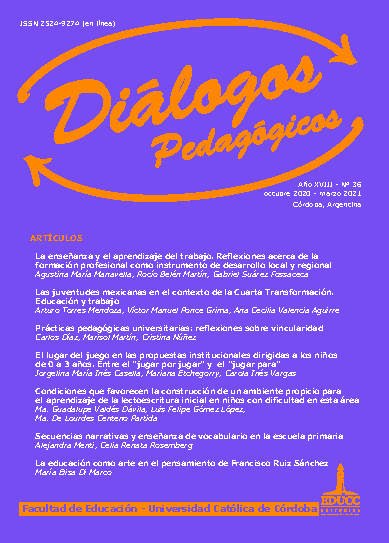El lugar del juego en las propuestas institucionales dirigidas a los niños de 0 a 3 años. Entre el "jugar por jugar" y el "jugar para"
DOI:
https://doi.org/10.22529/dp.2020.18(36)04Abstract
This article is part of a research project developed at the Provincial Universityof Córdoba. Its main purpose was to analyze institutional devices around playtime topromote the right of education to children from 0 to 3 years old. The methodologicaldesign we chose is qualitative and descriptive. It is part of the interpretative symbolicparadigm. Thanks to the fact that we were able to observe and interview teachers fromdifferent institutions, we collected data that allowed us to envision different conceptionsof "education", "childhood" and "play". The teachers' discourses were analyzed fromtwo main points; on one hand, "the space for playing time during homework" and -onthe other hand- "the assumptions around playtime". After a deep analysis, we couldobserve the multiplicity of meanings that allow us to think about a tension generatedbetween "playing just to play" and "playing with a purpose".Keywords: children's rights, infancy, play.Downloads
References
Agamben, G. (2007). Qu'est-ce qu'un dispositif? Paris: Éditions Payot & Rivages.Traducido por R. J. Fuentes Rionda.
Argentina. (2005). Ley N° 26.061. Ley de Protección Integral de los Derechos de Niños, Niñas y Adolescentes.
Argentina. (2006). Ley N° 26.206. Nueva Ley de Educación.
Bernstein, B. (1998). Pedagogía, control simbólico e identidad. Madrid: Morata.
Córdoba, Argentina. (2011). Ley N° 9944, de Protección y Promoción Integral de Derechos de Niños, Niñas y Adolescentes.
Chokler, M. H. (2015). Cómo se juega el niño cuando juega. Concepto de juego.Las raíces de la actividad lúdica. Istituto per la formazione e la ricerca aplicatta.Recuperado de: http://www.ifra.it/idee.php?id=15.
Dente, L. (2017). El juego en el nivel inicial. Clase 9 [Material del aula] Curso deposgrado Educación Inicial y Primera Infancia. Flacso Virtual Argentina.
Deleuze, G. (1990). ¿Qué es un dispositivo? En G. Deleuze, A. Glucksmann, M.Frank, E. Balbier et al., Michel Foucault filósofo (pp. 155-163). Barcelona: Gedisa.
Foucault, M. (2002). Vigilar y Castigar. Nacimiento de la prisión. Buenos Aires:Siglo XXI.
Larrosa, J. (2018). P de profesor. Buenos Aires: Noveduc.
Lewkowicz, I. & Coria, A. (2004). Pedagogía del aburrido. Escuelas destituidas,familias perplejas. Buenos Aires: Paidós Ibérica.
ONU. (2013). Observación General N° 17 sobre el derecho del niño al descanso, elesparcimiento, el juego, las actividades recreativas, la vida cultural y las artes(art. 31). Comité de los Derechos del Niño de las Naciones Unidas. Recuperado de:https://www.bienestaryproteccioninfantil.es/imagenes/tablaContenidos03SubSec/G1342831.pdf.
Orezzio, F. (2012). Proyectos en juego. Experiencias infantiles, espacios y lugarespara jugar: juego y prácticas comunitarias. Buenos Aires: Fundación Navarro Viola.
Paín, S. (1974). Diagnóstico y tratamiento de los problemas de aprendizaje. Buenos Aires: Nueva Visión.
Sarlé, P. (2012). Proyectos en juego. Experiencias infantiles, espacios y lugares para jugar: juego y educación infantil. Buenos Aires: Fundación Navarro Viola.
Sarlé, P. (2016). Juego y educación inicial. En V. Feld (Comp.), Enseñar a jugar para crecer. Miradas a la infancia (pp. 35-48). Buenos Aires: Noveduc.
Ulloa, F. (2005). Sociedad y crueldad. Recuperado de: http://repositorio.educacion.gov.ar:8080/dspace/handle/123456789/95946.
Vygotski, L. S. (2009). El desarrollo de los procesos psicológicos superiores. Buenos Aires: Crítica.
Winnicott, D. (1993). Realidad y juego. Barcelona: Gedisa.
Downloads
Published
Issue
Section
License
Copyright (c) 2020 Diálogos Pedagógicos

This work is licensed under a Creative Commons Attribution-NonCommercial-NoDerivatives 4.0 International License.








